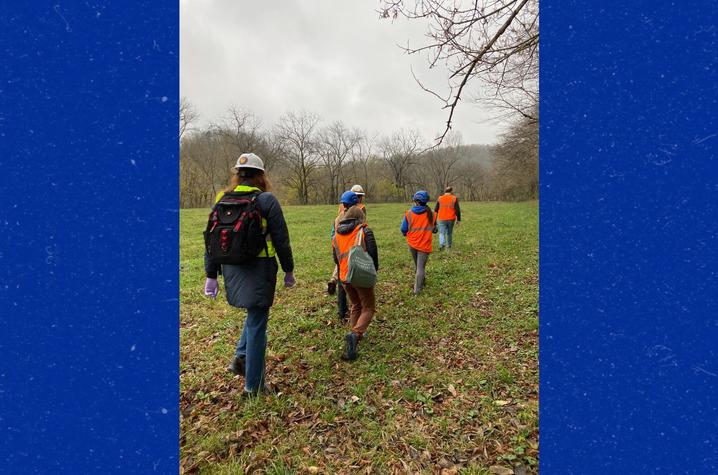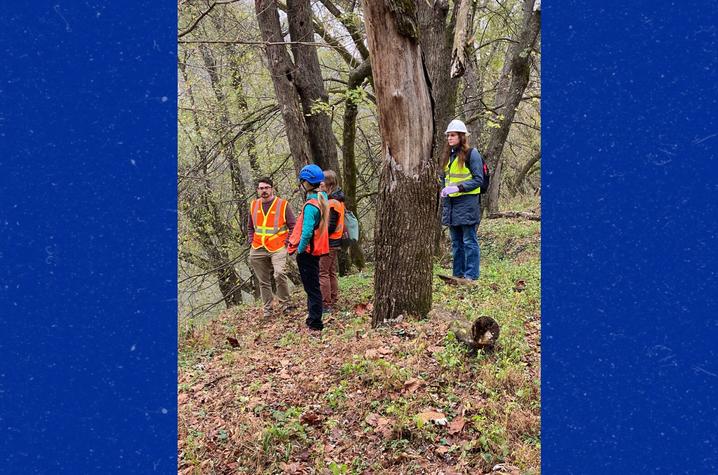KGS internship offers students hands-on research, career insight in geology
LEXINGTON, Ky. (March 7, 2025) — From the Bluegrass region to the Cumberland Plateau, Kentucky’s geology is rich and diverse. So is the research conducted by the Kentucky Geological Survey (KGS) at the University of Kentucky.
The hands-on work is yearlong. This past fall, geologists went out to check out the Mundy’s Landing field site on the banks of the Kentucky River for this summer’s Paul Edwin Potter Internship program.
Undergraduate and graduate students in Kentucky and the surrounding area can apply for the Potter internship. It gives students who may not have previous experience in geology a chance to work with a mentor and develop their interests.
“Geology will be involved in the research that interns do,” said Elizabeth Adams, the internship’s program coordinator at KGS. “Geology is also very much an interdisciplinary science, it touches everything.”
The internship launched in 2022, thanks to a gracious gift from the late Paul Edwin Potter, Ph.D., a former professor of geology at the University of Cincinnati and a pioneer in the field.
“We had 33 applicants this year who have backgrounds in anthropology, criminology, mathematics, a lot of environmental science and biology,” Adams said.
While many people think geology is only about rocks, Sarah Arpin, a geologist in the KGS Water Section, said it’s so much more than that.
“We’re mapping landforms, looking at hazards, looking at water quality — and all of those things impact lives,” Arpin said. “The internship will expose students to the many facets of geology and the natural heritage of Kentucky.”
Meredith Swallom, a geologist in the KGS Mapping Section, said geology sometimes gets overlooked as a discipline, but it offers something for everyone interested in science, history and even art.
“The career possibilities are vast,” Swallom said. “One of the intents with this internship program at KGS is to show people what their job could actually look like, whether they are a geology student or not.”
Geology also offers students a variety of opportunities to learn in different settings.
“One of the nice things about this program has been we’ve been able to offer a lot of different experiences to these students,” said Doug Curl, KGS geoscience information management section head. “If they want to go out in the field, they can. If they want to stay in the lab, that is fine too.”
Curl said students also learn about data management, sample collection, data modeling, safe fieldwork and research writing.
Each Potter intern will have a defined project to develop results they can discuss at the Paul Edwin Potter Internship showcase. Mentors and interns will work together as a research team.
“The showcase allows students to give an elevator pitch — a five-minute presentation — about their research. There is also a poster session,” Adams said. “And, by doing the field work together, they’re all collecting data that is used for multiple projects.”
Adams said many students who apply for the internship do not know what they want to end up doing.
“The Potter internship program exposes the students to a variety of career possibilities and research experiences,” Adams said. “It’s a very immersive program and we hope it opens their eyes to the wide range of possible geoscience careers.”
The internship is open to anyone who wants to learn more about geology. Learn more about the Potter internship with KGS online.
As the state’s flagship, land-grant institution, the University of Kentucky exists to advance the Commonwealth. We do that by preparing the next generation of leaders — placing students at the heart of everything we do — and transforming the lives of Kentuckians through education, research and creative work, service and health care. We pride ourselves on being a catalyst for breakthroughs and a force for healing, a place where ingenuity unfolds. It's all made possible by our people — visionaries, disruptors and pioneers — who make up 200 academic programs, a $476.5 million research and development enterprise and a world-class medical center, all on one campus.






